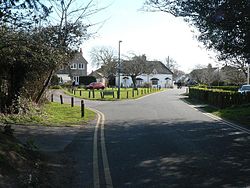Wick, Bournemouth
| Wick | |
|---|---|
 Wick: the green |
|
| Wick shown within Dorset | |
| OS grid reference | SZ155921 |
| Unitary authority | |
| Ceremonial county | |
| Region | |
| Country | England |
| Sovereign state | United Kingdom |
| Post town | BOURNEMOUTH |
| Postcode district | BH6 |
| Dialling code | 01202 |
| Police | Dorset |
| Fire | Dorset and Wiltshire |
| Ambulance | South Western |
| EU Parliament | South West England |
| UK Parliament | |
Wick is a village on the southern bank of the River Stour in Dorset, England, just short of the Stour's entry into Christchurch Harbour. Along with the nearby village of Tuckton, this originally formed a tithing in the Hundred of Christchurch, before becoming part of the Civil Parish of Southbourne in 1894. The latter was incorporated into the Borough of Bournemouth in 1901.
The village name derives from the Old English wīc, meaning "dairy farm". The village is mentioned in the ministers' accounts for the Manor of Christchurch in 1301, at which point the king (as Lord of the Manor) could claim the second-best sheep from every customary fold in Wick (there being at that time six folds), while the tenants in return were allowed pasture in the "demesne arable land" outside the ditch of Hengistbury.
There are two references to a "Manor of Wick" in the Christchurch Cartulary, a series of charters drawn up by the monks of Christchurch Priory. The first comes in 1331 in a survey of splotgabulum, a type of land tax payable to the clergy. From this, we learn that the Manor of Wick contained 276 acres of arable land, a messuage taxed at one shilling per year, and a dovecote which had grown dilapidated during the reign of Edward II, and had fallen down. The second reference comes in 1406 when we read that, on 13 October that year, a large fish ("uni magno piscis"), 18 ft. long, had been washed up at "La Bournemowthe" and taken to the Manor of Wick, where it was cut into forty pieces. Four days later, Canon John Leye ventured across from the Priory and was handed four portions of the fish as tithe. This, incidentally, is the earliest known reference to Bournemouth as a toponym.
...
Wikipedia

